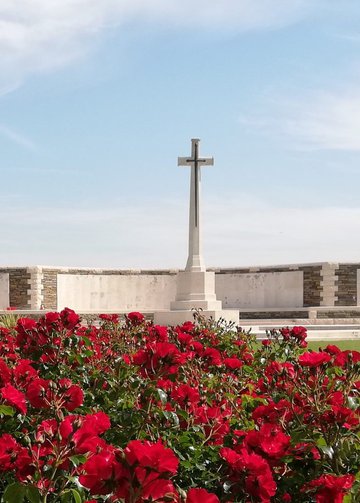William BEITH
Eyes grey, Hair brown, Complexion dark
Looking for William - The search goes on
Can you help find WIlliam?
William’s body was never recovered after the Battle of Fromelles. His name is carved in stone among the missing on the V.C. Corner Memorial, but his final resting place remains unknown.
A mass grave was uncovered at Pheasant Wood in 2008, where German forces had buried 250 Australian and British soldiers killed in the battle. Thanks to DNA and historical research, over 180 of these men have now been identified.
Despite extensive searches across Australia, Scotland, and the United States, no suitable Y-DNA donor has yet been located. William had one son, but no known male-line descendants. His three brothers — Daniel James Beith, John (Jack) Beith, and possibly others — may hold the key through their male-line descendants.
If you are a male descendant of the Beith family, especially from William’s paternal grandparents Robert Beith and Elizabeth Pride of Campbeltown, Argyll, Scotland — you may be able to help.
In more recent years, the army, family and numerous volunteers have tried to locate family members who may be able to provide DNA to help identification. There was great delight when a mitochondrial DNA match was found however the hunt continues across Australia, Scotland and the United States for family members who may share Y DNA and so end the search for the final pieces of the puzzle to identify William and lay him to rest.
So, who was William Beith?
William was born in 1879 in Dunolly, a small rural town just west of Bendigo, Victoria - one of four sons and six daughters born to Daniel Beith, a baker from Glasgow (1837-1908) and Emma Blake (1842-1895). Emma was born to a pioneering outback family of South Australia. It is not clear how or when Daniel came to Australia, but they married in Inglewood Victoria in August 1860. His occupation is listed variously as farmer or miner, a likely combination in a rural area of the Grampian goldfields.
The Beith family
- Elizabeth Ann 1862-1953 m Charles Simpson
- Daniel1864- 1865 died infancy
- Mary Pride 1866-1930 m John Waugh
- John (Jack) 1868-1925
- Emma 1871-1948 m Oliver Atherton
- Anne 1874-1942 m Tanner
- Daniel James 1877-1960
- William 1879-1916 Fromelles
- Ellen 1883-1963 m Frank Tuckett
- Alice 1885-1917 m Walter Ogilvie
Little is known of the Beiths’ family life or of William prior to enlistment. There are listings of a William Beith, miner, in Western Australia in the early 1900s who may be Private Beith but there is insufficient information to be sure; it would certainly fit with his experience growing up on the goldfields. From his inclusion on the NSW Railways and Tramways Honour Roll, it also appears that William was employed in the Tramways branch at one time.
On his enlistment in September 1915, William stated his occupation as labourer. He also stated that he was 34 and single, nominating his older sister, Emma, as next of kin. It seems, however, that this situation changed during his training prior to embarkation. In September 1916, a letter arrived at Army Headquarters asking that Mrs Amelia Beith be listed as next of kin and seeking information about her husband.
Mrs Beith, formerly Miss Amelia Jane Riley, was able to provide evidence that she and William had been married In Sydney on 15 December 1915 just a fortnight before he embarked for Egypt. She also provided evidence that she had a son born on 5th April 1916 in Paddington – registered as William Daniel Beith, but commonly referred to as Daniel William Beith. Accordingly, she was listed as next of kin and awarded a pension for herself and their young son from October 1916.
William’s experience of war
Egypt
With the huge losses of men from Gallipoli and all the new recruits from Australia arriving in Egypt, major reorganizations were underway. The AIF expand from two infantry divisions to five.
The 56th Battalion was raised in Egypt on 14 February 1916 at Tel-el-Kebir. Half of its recruits were Gallipoli veterans from the 4th Battalion, and the other half, fresh reinforcements from Australia. Reflecting the composition of the 4th, the 56th was predominantly composed of men from New South Wales. There would be many challenges in organizing them into an effective fighting unit however, as on 17 Feb they were described as being “a mixed lot and very raw”. [[Source: AWM4 23/71/1, 56th Battalion War Diaries, February 1916, page 6]]
On 22 March H.R.H. the Prince of Wales visited the troops and he was greeted with “enthusiastic cheers”. [[Source: AWM4 23/71/2, 54th Battalion War Diaries, March 1916, page 13]]
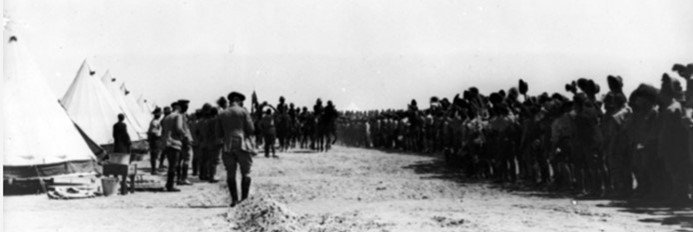
At the end of March they began to move towards Ferry Post at the Suez Canal, a three day, 60 km walk. It was a significant challenge, marching over the soft sand in the 38°C heat with each man carrying their own possessions and 120 rounds of ammunition.
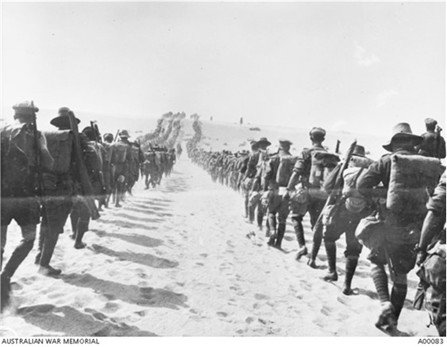
At Ferry Post their training continued as well as guarding the Suez Canal. By the end of April it was noted in the War Diaries that “A very great improvement is now noticeable in the men’s work.” [[Source: AWM4 23/73/3, 56th Battalion War Diaries, April 1916, page 3]]
The soldiers were at Ferry Post and the Duntroon Plateau until mid-June. It was not all work however, they did get to swim in the Suez Canal and there was a Brigade sports day held on 10 June.
To the Western Front
Soon after the sports day, orders to move to the Western Front were received and on 20 June, 990 soldiers of the 56th embarked from Alexandria on HMT Huntsend, headed for Marseilles. They did spend some time enroute at Malta before arriving in Marseilles on 29 June. All were then put on trains for a 60+ hour train trip to their camp at Thiennes, 30 km from Fleurbaix.
Harry Grubb (2678, 56th Battalion) summed up his experiences to date in a letter he wrote home soon after having arrived in France to say that he was “in the best of health, and greatly relieved to be away from Egypt’s sandy deserts”. He found French girls good-looking and the country beautiful, likening the crops to the family property “The Meadows” at its best. He signed off asking that he be remembered to all old friends.
Source: SOLDIERS' LETTERS. (1916, August 29). Goulburn Evening Penny Post (NSW : 1881 - 1940), p. 4 (EVENING), http://nla.gov.au/nla.news-article98892446
The Battalion then moved on to Estaires, just 10 km from the trenches. Training continued now with gas helmet practice, Lewis gun training and route marches. The last leg of their trip was on 12 July and the 56th were into trenches for the first time. They were immediately subjected to artillery shelling and a gas alert. The spent the next three days there before being relieved. Orders were issued for an attack on the 17th, but it was postponed due to the weather.
The Battle of Fromelles
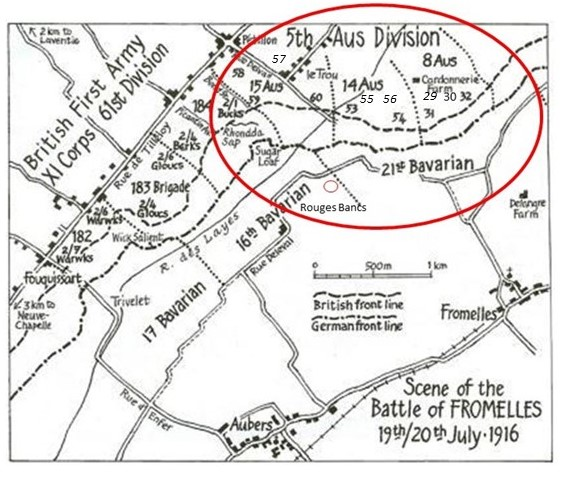
On 19 July, the battle began.
The 56th’s role was to provide support for the attacking 53rd and 54th Battalions by digging trenches and providing carrying parties for supplies and ammunition. They would be called in as the ‘fourth battalion’ if needed for the fighting.
The main objective for the 14th Brigade was to take the trenches to the left of a heavily armed, elevated German defensive position, the ‘Sugar Loaf’, which dominated the front lines. If the Sugar Loaf could not be taken, the Australians would be subjected to murderous enfiled fire from the machine guns and counterattacks from that direction. As they advanced, they were to link up with the 31st and 60th Battalions.
The 53rd and 54th went on the offensive from 5.43 PM. They did not immediately charge the German lines, but went out into No-Man’s-Land and laid down, waiting for the British bombardment to lift. At 6 PM the German lines were rushed. There was heavy artillery, machine gun and rifle fire, but they were able to advance rapidly.
Some of the advanced trenches were just water filled ditches, which needed to be fortified to be able to hold their advanced position against future attacks.
The 53rd and 54th were able to link up with the 31st and 32nd, occupying a line from Rouges Bancs to near Delangre Farm, but the 60th on their right had been unable to advance due to the devastation from the machine gun emplacement at the Sugar Loaf.
At 8 PM A and B Companies of the 56th were called to be in position at the 300 yard line between the communication trenches in the Brompton Ave and Milne Ave areas. Heavy shelling of this area was underway. At 9.15 they advanced to the front-line trenches.
While in position at the front trench, very specific orders were received “to the effect that on no account whatever were these two Companies to leave the original front line trenches.”
Source: AWM4 23/14/4 14th Brigade July 1916 page 109
At 11 PM, B Company was called upon to dig a trench to the advance trenches, which they completed by 3 AM. It was duck-boarded and it greatly facilitated the movement of munitions to the attacking battalions as well as enabling the saving of “numerous lives” during the retirement of the troops the next morning. The Unit diary notes proudly “that it was the only trench in the Division, to be dug across “No man’s land”” – and this was achieved whilst under fire. [[Source: AWM4 23/73/6, 56th Battalion War Diaries, July 1916, page 9]]
The attacking battalions held their lines through the night against “violent” attacks from the Germans from the front, but their exposed right flank had allowed the Germans access to the first line trench BEHIND them, requiring the Australians to later have to fight their way back to their own lines.
At 5 AM on the 20th, C & D Companies were moved forward to the 300 yard line. By 5:50 they had moved to the front lines to provide support for the retiring troops and to protect against German counterattacks. The German artillery was being directed at them, “great gaps were blown in the 300 yds line trench.” Source: AWM4 23/73/6, 56th Battalion War Diaries, July 1916, page 10
By 9 AM orders were received for the Brigade to retreat from positions won, but a number of the 56th B Company men went forward to help their mates against the German grenade attacks.
Shortly after this, A, B & C Companies were called back to garrison the Brigade HQ. D Company remained at the 300 yard line as reserves, if needed.
By 9.30 AM the Brigade had “retired with very heavy loss”.
Source: AWM4 23/14/4 14th Brigade July 1916 page 7
All other Units were out of the trenches by 11.00 AM and collection of the wounded in the trenches continued in earnest. The artillery finally ceased at noon.
As no ceasefire was called after the battle, recovery of the wounded that remained on the battlefield was risky. During the next two nights, the 56th recovered over 100 wounded soldiers from No-Man’s-Land.
The 56th were then relieved and by 10.00 PM on the 21st they were in billets in Bac St Maur, 4 km from the front.
For a battalion that was to be in reserve as the ‘fourth battalion’, the initial count at roll call was 12 killed, 77 wounded and 13 missing. Ultimately the impact was that 50 soldiers were killed or died from wounds. Of this total, 7 remain missing/unidentified.
None of these unidentified soldiers have been found to be in the mass grave that the Germans dug at Pheasant Wood which was discovered in 2008. To date (2023), DNA donations from family members have allowed 173 of the 250 soldiers in this grave to be identified
After the battle, the 56th Battalion remained in the Fleurbaix area. They worked in the frontline and support trenches carrying out fatigue duties, patrols and relief duties and were regularly subject to artillery shelling, snipers and machine gun fire.
From the records at the Court of Inquiry held in July 1917 we know a little of what happened to William before he went missing on 20th July 1916. Lance Corporal John Somerville (B Company, 56th Battalion) was noted as being a careful witness and he gave evidence about William twice – the first time in October 1916 and then again in June 1917 while a patient in the hospital at Rouen. Somerville said:
I knew Beith……he was bombing at Fromellles on 20.7.16 with Cpl now Sgt Maurice Phillips who got his D.C.M for his work that night. Phillips told us that Beith was bombing right up in the main front line and he did not come back, and he was positive Beith was killed, although he did not actually see it. The German line was 200 odd yards from our line, and if not dead, must be a prisoner……
and later, he stated:
We went over the top at Fromelles on July 20th and he did some splendid work throwing bombs. Sgt. Phillips got the D.C.M. as he himself admits for the work that Beith did and the Sgt. was the last man to see him in the German trench and is quite sure that he was killed. We were driven back so that he was not buried.
Sergeant Morris Phillips (who was awarded the D.C.M. in August 1916 for his actions at Fromelles) stated in relation to William Beith:
No. 3038A Pte Beith W. was in B Coy 56th Bn on 19.7.16. I was his Section Commander. Early in the morning of 20.7.16 while the Bn was in action a call was made for volunteer bombers. He and I went. While bombing the enemy, the supply of bombs ran short and I was sent back with a written message………..On my return with a supply of bombs, the retirement was taking place and there were many dead lying there. I have not seen Pte Beith since.
So, it seems that William was extremely courageous in volunteering as a bomber and gave his all to do his part in the battle. He did not survive and never came home to meet his infant son.
Although William Beith’s body was never recovered, his sacrifice has not been forgotten.
He is commemorated on the V.C. Corner Australian Cemetery and Memorial at Fromelles, France — one of over 1,300 Australians remembered there with no known grave.
William’s name is also inscribed on the New South Wales Government Railways and Tramways Honour Roll at Central Station, Sydney, where he had been employed before the war in the Tramways Branch. This roll bears the names of railway employees who served during the First World War, many of whom, like William, never returned.
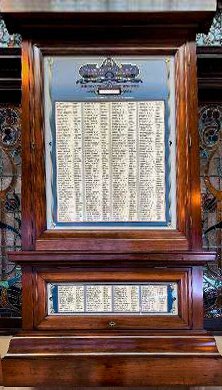
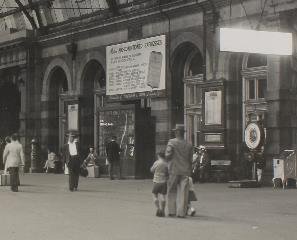
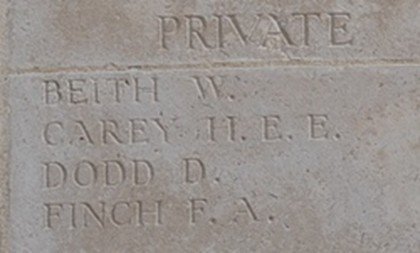
The Vaudeville Connection.
And what of Amelia Jane and baby Daniel Beith? As it turns out, Amelia had lived a colourful life in Vaudeville. Her previous partner Harry (Henry) Thomas Kane, (stage name Marlow) and their several children were waiting in the wings. She returned to that life, and young Daniel grew up in a very busy and loving family, his half siblings included: Frank Kane Marlow b 1906, Thomas Henry Kane, 1907 Samuel Kane, 1909 Billy Kane 1911, Mary Kane 1913, and Douglas Bruce Kane Beith, who was born in 1923.
As she lived to 1964, this must have helped Amelia through the Depression and WW2, when son Daniel enlisted: Daniel William Beith NX 44884, 2/110 Australian General Transport Company.
Amelia’s youngest son Douglas Bruce Beith also enlisted at age 18 in WW2, Reg No 263786, 55th Battalion.
Waiting for closure for William's family
Back in Australia, the family awaited news of William but it is clear that the change in next of kin caused delays in information about William’s fate being received by his wife and by his siblings, adding to their pain and confusion. And today, the broader family connections still wait as they seek the last DNA evidence needed to be able to finally lay William to rest. For over a century, the search to finally know the fate of William Beith has continued. Posted as missing at Fromelles in 1916, for years afterwards, his sister (Emma) and his wife (Amelia) made separate enquiries of the army and the Red Cross.
While the Army’s court of inquiry in 1917 found that he had been killed in action, the family could never be entirely sure. In fact, his wife made enquiries of the army in 1918 having been told that he had returned from overseas and was looking for her. This lack of certainty and closure could only have exacerbated the family’s grief.
Researchers are still seeking donors who may share YDNA with William. This is most likely to come through his paternal grandparents as we can find no suitable descendants from either William’s brothers or his son. His paternal grandparents were
Robert BEITH born 1811, Campbeltown, Argyll, Scotland - died 1867, St Louis, Missouri, USA Elizabeth PRIDE born circa 1811, died before 1851 in Argyll, Scotland.
DNA samples are being sought for family connections to
| Soldier | William Beith (1879–1916) |
| Parents | Daniel Beith (1837–1908) – born Glasgow, Scotland Emma Blake (1842–1895) – born South Australia |
| Siblings | Elizabeth Ann Beith (1862–1953) – m. Charles Simpson | ||
| Mary Pride Beith (1866–1930) – m. John Waugh | |||
| John "Jack" Beith (1868–1925) | |||
| Emma Beith (1871–1948) – m. Oliver Atherton | |||
| Anne Beith (1874–1942) – m. Mr Tanner | |||
| Daniel James Beith (1877–1960) | |||
| Ellen Beith (1883–1963) – m. Frank Tuckett | |||
| Alice Beith (1885–1917) – m. Walter Ogilvie |
| Grandparents | ||||
| Paternal | Robert Beith (1811–1867), Campbeltown, Argyll, Scotland → St Louis, Missouri, USA Elizabeth Pride (c.1811–bef.1851), Argyll, Scotland | |||
| Maternal | [Currently unknown – seeking further information] |
Seeking DNA Donors

Contacts
(Contact: carla@fromelles.info or geoffrey@fromelles.info).
(Contact: army.uwc@defence.gov.au or phone 1800 019 090).
Donations
If you are able, please contribute to the upkeep of this resource.
(Contact: bill@fromelles.info ).
